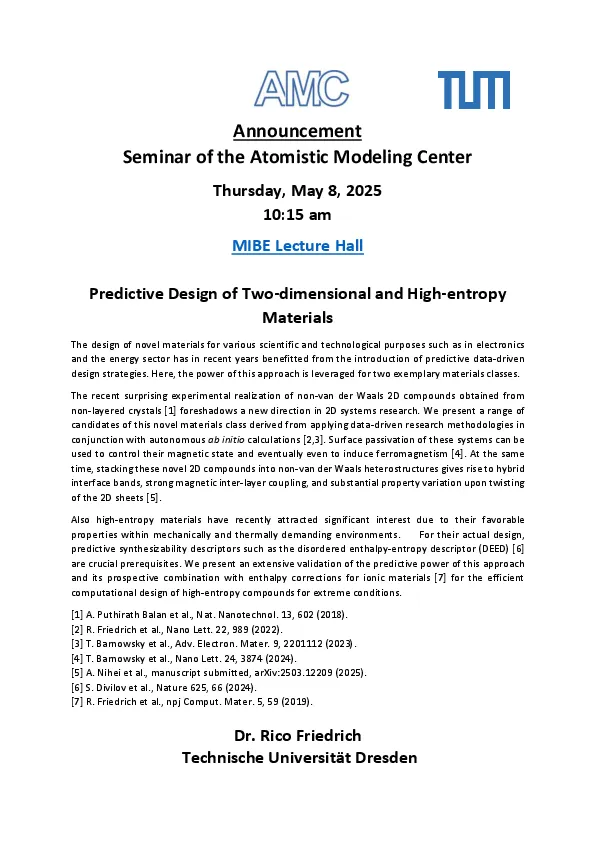AMC is offering a Seminar Series on Atomistic Modeling this summer semester!
Dr. Rico Friedrich leads the Dresden-concept Research Group AutoMaT jointly run by the Chair of Theoretical Chemistry at TU Dresden and the Institute of Ion Beam Physics and Materials Research at the Helmholtz-Zentrum Dresden-Rossendorf (HZDR). He will talk about “Predictive Design of Two-dimensional and High-entropy Materials”.
Date: May 8, 2025, 10:15 am
Location: MIBE Lecture Hall
Abstract:
The design of novel materials for various scientific and technological purposes such as in electronics and the energy sector has in recent years benefitted from the introduction of predictive data-driven design strategies. Here, the power of this approach is leveraged for two exemplary materials classes.
The recent surprising experimental realization of non-van der Waals 2D compounds obtained from non-layered crystals [1] foreshadows a new direction in 2D systems research. We present a range of candidates of this novel materials class derived from applying data-driven research methodologies in conjunction with autonomous ab initio calculations [2,3]. Surface passivation of these systems can be used to control their magnetic state and eventually even to induce ferromagnetism [4]. At the same time, stacking these novel 2D compounds into non-van der Waals heterostructures gives rise to hybrid interface bands, strong magnetic inter-layer coupling, and substantial property variation upon twisting of the 2D sheets [5].
Also high-entropy materials have recently attracted significant interest due to their favorable properties within mechanically and thermally demanding environments. For their actual design, predictive synthesizability descriptors such as the disordered enthalpy-entropy descriptor (DEED) [6] are crucial prerequisites. We present an extensive validation of the predictive power of this approach and its prospective combination with enthalpy corrections for ionic materials [7] for the efficient computational design of high-entropy compounds for extreme conditions.
[1] A. Puthirath Balan et al., Nat. Nanotechnol. 13, 602 (2018).
[2] R. Friedrich et al., Nano Lett. 22, 989 (2022).
[3] T. Barnowsky et al., Adv. Electron. Mater. 9, 2201112 (2023).
[4] T. Barnowsky et al., Nano Lett. 24, 3874 (2024).
[5] A. Nihei et al., manuscript submitted, arXiv:2503.12209 (2025).
[6] S. Divilov et al., Nature 625, 66 (2024).
[7] R. Friedrich et al., npj Comput. Mater. 5, 59 (2019).
